JAPANESE DESIGN AND INNOVATION
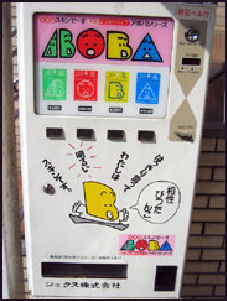
blood-type condom
vending machine Japan has a reputation for copying things and making them better. The religious scholar G. Bownas wrote: “Throughout their history, the Japanese have been imitative, yet, in their way, not uninventive; they have often applied strokes of inventive genius to transform what they have borrowed, thereby producing something eminently suited to the new environment, something that is very much more than the mere sum of the borrowed components.”
Design has been a big part of the success of Japanese products. "By the yardstick of sales," wrote Benjamin Forgey in the Washington Post, "the most widely appreciated of Japan's design attributes is this genius for making small beautiful things. Derived from the need for compact living spaces on a densely populated, mountainous island (and who knows what else), it is a gift heaven-sent for the information age: the world buys Japan's sophisticated little radios, televisions, telephones, cameras, calculators and computers." [Source: Benjamin Forgey, the Washington Post]
Muji (“no mark”) is a leader in design for everything from food to bicycles. It strives for a kind banality chic by designing products that achieve the ultimate in simplicity and functionality. Japan's formost designer Yusaku Kamekura has said he was Inspired by C-ration boxes discarded by American GIs. He said, "Displaying them on shelves, I felt as though a fresh air of civilization and culture was suddenly filling my room...I thought this civilization, this design."
Unique electronics from the 1950s and 60s included a "walking-type" toaster that was produced by Toshiba Corp. in 1959. A slice of bread was inserted in one side of the toaster and when it was done it came out the opposite side. Toshiba's Snack 3, made in 1965, enabled people to make toast, hot milk and a sunny-side up egg at the same time. The Sharp Cinema Super, a TV-shaped radio released in 1956, looked like a TV set because the manufacturer thought people who could not afford a TV would be able to buy the radio and feel like they were watching television. [Source: Ryotaro Maeda, Yomiuri Shimbun, August 30, 2012]
Websites and Resources
Good Websites and Sources: Japan Sugoi japansugoi.com/wordpress/category/japan-technology ; 3 Yen — Japanese Gadgets gadgets.3yen.com ; Japan Gadgets Shop japangadgetshop.com ; Japan Trend Shop japantrendshop.com ; Japan Technology Information japantechniche.com ; Gadgets and Consumer Electronics Blogs blogged.com/directory/shopping/consumer-electronics ; Cool Japanese Cell Phones crunchgear.com/ ; Cool Japanese Toys cooljapanesetoys.com ; Gadgets in Japan (last post in March 2009) gadgets-in-japan.com ; Japan Trends japantrends.com ; Books: “Japan Design” by Sarah Lonsdale (Carlton, 2001), an interesting survey of traditions and recent trends in architecture, packaging, and gadgets; “Origins: The Creative Spark Behind Japan’s Best Product Designs” bu Shu Hagiwara (Kodasha International, 2007); “Design Japan: 50 Creative Years with the Good Design Awards” by Japan Industrial Design (Stone Bridge Press, 2007).
Inventions Funny and Strange Japanese Inventions nikibrown.com/designoblog ; 32 Japanese Inventions uniquescoop.com ; Informal Poll on Best Japanese Inventions bestuff.com/category/japanese-invention ; Useless Japanese Inventions hongkiat.com/blog/useless-japanese-inventions ; Video of Weird/ Cool Japanese Inventions You Tube ; Wikipedia List of Japanese Inventions Wikipedia
Links in this Website: SCIENCE IN JAPAN Factsanddetails.com/Japan ; NOBEL PRIZES IN JAPAN Factsanddetails.com/Japan ; JAPANESE SPACE PROGRAM Factsanddetails.com/Japan ; TECHNOLOGY IN JAPAN Factsanddetails.com/Japan ; GADGETRY AND INVENTIONS IN JAPAN Factsanddetails.com/Japan ; ROBOTS IN JAPAN Factsanddetails.com/Japan ; SONY, TOYOTA AND HONDA ROBOTS Factsanddetails.com/Japan ; UNIVERSITIES IN JAPAN Factsanddetails.com/Japan ;INDUSTRIES IN JAPAN Factsanddetails.com/Japan ; HYBRIDS, FUEL CELLS AND ELECTRIC CARS IN JAPAN Factsanddetails.com/Japan ; HONDA CARS, PLANES, ROBOTS AND RACING Factsanddetails.com/Japan ; JAPANESE ELECTRONICS INDUSTRY Factsanddetails.com/Japan ; JAPANESE ELECTRONICS COMPANIES Factsanddetails.com/Japan ; CANON, SHARP AND TOSHIBA Factsanddetails.com/Japan ; SONY Factsanddetails.com/Japan ; SONY PRODUCTS Factsanddetails.com/Japan ; PANASONIC Factsanddetails.com/Japan ; TRAINS IN JAPAN Factsanddetails.com/Japan ; SHINKANSEN (JAPANESE BULLET TRAINS) Factsanddetails.com/Japan
Good Websites and Sources on Science: Japan Science and Technology Agency jst.go.jp/EN ; MEXT, Ministry of Education, Culture, Sports, Science and Technology mext.go.jp/english ; Science Links Japan sciencelinks.jp ; Stanford University J-Guide to Science and Technology jguide.stanford.edu ;Japan Advanced Institute of Science of Technology jaist.ac.jp ; Japan Institute of Invention and Innovation jiii.or.jp/english ; Statistical Handbook of Japan Science and Technology Chapter stat.go.jp/english/data/handbook ; 2010 Edition stat.go.jp/english/data/nenkan ; News stat.go.jp ; Trends in Japan: Science and Technology web-japan.org/trends/science ; Book: “Japanese Science From the Inside” by Samuel Coleman (Routledge, 2000).
Science Museums National Museum of Nature and Science kahaku.go.jp/english ; Museum of Natural History — Tohuku University dges.tohoku.ac.jp/museum ; Osaka Museum of Natural History mus-nh.city.osaka.jp ; National Science Museum (Ueno Park in Tokyo) kahaku.go.jp National Museum of Nature and Science and Technology Tokyotopia tokyotopia.com ; Research Centers: Tsukuba Science City Wikipedia Article Wikipedia ; Fujitsu Laboratories fujitsu.com/group/labs ; Hitachi Research Laboratories hitachi.com/rd/hrl ; Toshiba Research and Development Center toshiba.co.jp
Appeal of Japanese Products

18th century writing box Japanese products are reliable and inevitably operate very well. A representatives of a United States elevator company once explained, "Japanese elevators are very smooth because the Japanese are very sensuous people, whereas the people in the Western world are more in a hurry and a smooth ride isn't considered as important."
Describing a Japanese-made travel pack he was given Benjamin Forgey of the Washington Post said: "The thing seemed perfect in its way, a Platonic miniature. The utensils — ruler, scissors, spool of transparent tape, stapler, glue container, razor cutter, tape measure — were satisfying to the eye and hand alike. About as long as my index finger, the scissors cut a precise edge. Scarcely bigger than a thumbnail, the stapler stapled."
Among the items that have drawn attention at Tokyo Designer Week in recent years have been H Concept’s Animal Rubber Bands, colorful silicon bands in the form of 12 animal, including giraffes, cats and turtles; Cao Maru, a stress ball in the shape of a squishy human head; Qurz Monacca zabuton, a cushion made from wood and filled with agglomerated cork that looks hard and uncomfortable but flexes to the shape of the body and is actually quite comfortable; and Taku Satoh’s Maybelline eye shadow case, designed so figuring out how to open it is half the fun.
Japanese Micromachines and Ultrafast Machines
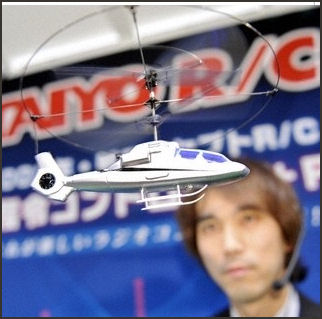
mini helicopter Japan is very advanced in micromachines. Japanese scientists have produced a bullet-size completely wireless camera that transmits data via radio waves, and two-millimeter-long "micro-reducer" transmissions with five gears.
In 2001, a team led by a Satoshi Kawata of Osaka University produced realistic-looking, three-dimensional models of bulls about the size of red blood cells with a laser. The same nanotechnology used to make the blls can used to make extremely small electronic devices and machines.
According to the Guinness Book of Records, the smallest robot (0.06 cubic inches and 0.05 ounces) was made by Seiko Epson of Japan in 1992. It won an international hill-climbing competition.
Juken Kogyo Co. in Toyohashi, Aichi Prefecture has developed a cogwheel that weighs one millionth of gram. A team lead by Kazushi Kinbara at Tokyo University Education School of Engineering developed tweezers that can manipulate single molecules. The tweezers are three one-billionth of meter on length. The tool is made of organic compounds that respond to light placed on the molecules to be manipulated. The are structurally similar to scissors or forceps.
Prof. Masatoshi Ishikawa of the University of Tokyo has developed ultrafast cameras able to track movements every one thousandth of a second — more than 30 times faster than the human eye. Applications include 1) photographing books 200 pages per minute, as quick as a person can turn the pages; 2) cars that can avoid obstacles and react to dangers quicker than their drivers can; and 3) batting robots that can hit balls thrown at it up to 300 kph with almost a perfect batting average. For the book photographing a person sits at a desk and turns the pages under a camera set about head height. Images of each page are taken with the high-speed camera and a laser, with the laser helping to correct distortions made while the pages are moved.
Gadgets and Innovations in Japan

roof-top ferris wheel Japanese are willing to spend for the latest and coolest stuff in the smallest package while Americans are often interested most in the lowest price.
Tukuo Toda of Fukuyama in Hiroshima Prefecture holds the Guinness world record for paper airplane flight. In April 2009, he threw a two-gram plane made of sugar cane paper 18 meters in the air and watched as it slowly circled around a gymnasium, staying aloft for 27.9 seconds — taking 0.3 seconds off the previous record held by an American. Toda became fascinated with paper airplanes while recovering from an injury. He has launched planes from a hot air balloon and the Arc de Triumph in Paris and is currently working with a research company to make a airplane made from heat resistant paper that can be launched from space and land on the Earth’s surface. Gennai Yanagisawa, an inventor and owner of a machinery making factory in Matsumoto, holds the Guinness Record for world’s smallest helicopter. It consists of a seat suspended below two rotors. In one demonstration it flew 25 meters above the ground at Leonard Da Vinci airport in Rome.
Identification chip (IC) tags are used in Japan to identify pets, calculate the price of a meal at moving sushi restaurants, give robots instructions on which items to clean up, give instruction on expiration dates and fabrics to refrigerators and washing machines, provide quick product information at grocery stores, and various information on credit cards.
An increasing number of electrical and gas appliance makers are equipping their devises with voice guidance systems that say things like “the coffee in ready” instead of alarms and buzzers. Some find the system annoying. Others find it comforting. One elderly woman told the Yomiuri Shimbun, “I like it because it creates a lively atmosphere. I always reply to the machine, saying something like, “Yes, yes, thank you.” Manufacturers said they introduced the system because households are filled with so many appliances that people are often not sure which devices are buzzing or beeping
Toshiba has built the world’s fastest elevator. It can reach speeds of 1,010 meters per minute and is inside the world’s tallest building, Taiwan’s 101-story Taipei 101. Mitsubishi and Hitachi are currently trying to make elevators that can break the record — reaching speeds of 1,300 meters per minute — and are looking for buyers in the Middle East.
NEC has developed bioplastic that has a shape memorizing property that allows it return to its original shape when it is heated, The material has been used to make flexible cells phone and was featured in an episode of CSI.
High Tech Recreation and Relaxation in Japan
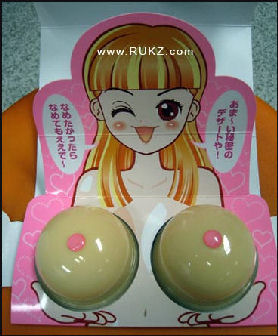
sweet breast pudding Japan is a leader in recreation technology. Because space is at a premium Japanese can go horse back riding, ski, go parachuting, or play golf without stepping outside. These sports are all done in front of a projection screen. Horseback riders sits on a mechanical horse that moves up and down while watching trails pass by on a screen.
To relieve stress some Japanese go to 'mind gyms' where they relax in special coffin size cubicals and listen to music and wear goggles with pulsing lights. Some stress relief salons feature aromatherapy capsules that offers scents, vibrations, relaxing music, psychedelic lights and heaters that can raise the temperatures to as high as 79̊C. A 30 minute stay in these capsules cost around $30.
Researchers at Matsushita Electric Works developed a virtual-reality, massage armchair with built in speakers and a headset that shows three-dimensional images of misty mountains, scenic valleys and beautiful sunsets. The vibrations and movements of the chair respond to signals from a heart-beat monitor attached to the users ears. The company spent $2 million developing the chair and expects stressed out salarymen to be its biggest customers.
Stressed Japanese securities traders often unwind by sticking their head inside music machines which look like giant hair dryers.
High-Tech Homes in Japan
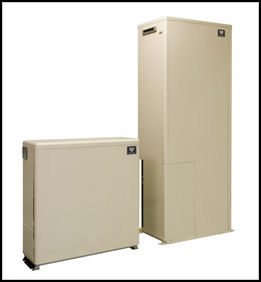
home fuel cell There are presently houses that have watering systems for plants that are activated by cell phone and covers for drying clothes that emerge when sensors detect rain. Rooms light up, and are cooled or heated when the people enter. Movement is detected by infrared detectors in the ceiling. Video cameras show what is going on outside the house. Singing mailboxes let people know when mail has arrived.
Matsushita is working on developing an automated kitchen on which people can chose a menu, order the ingredients and send instructions through the Internet on how to prepare it with a microwave.
To make interior spaces brighter and more appealing, a Japanese company invented a mirror system with light tracking censors that reflects 70 to 90 percent of the light from the sun into a building There are controls which allow the homeowner to regulate the amount infrared and ultraviolet light that is let in. A home system cost between $14,000 and $28,000 installed. [Source: Leonard Cohen, Discover magazine, June 1988. Cohen has written a book called "283 useful Ideas from Japan]
In 2005, Yamaha introduced 27-square-foot, soundproof, shed-like structure called MyRoom that is intended to be set up in houses to give its occupants some privacy in a crowded home. As it stands now you often see salarymen relaxing in their cars in isolated areas presumably for the same reason.
High-Tech Household Products in Japan
Matsushita (Panasonic) has developed smart house products like refrigerators that communicate with cell phones and tell homeowners what they need to buy at the store, networks of flat plasma televisions located throughout the house and television remotes that response to verbal orders such as change to Channel 5 or record the football game on Channel 62. Panasonic has also markets a $10,000 sleep assistance system, in which light gradually goes out and music softens as the person goes to sleep at night and gradually comes back on in the morning when they wake up.
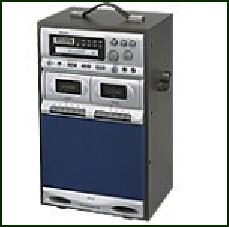
classic karaoke machine One Japanese company puts out a Buddhist alter with a body-temperature sensor that turns on a tape of a monk chanting sutras when someone sits before its. You can also find washing machines with an 18-minute cycle that scrub people rather than clothes, refrigerators that display their inventory, and health monitors that are linked directly to doctor's offices. Sharp produced a microwave that automatically produces recipes found on the Internet.
Toshiba has developed a whole line of smart appliances that operate on instructions sent by cell phones via the Internet. Refrigerators, air conditioners, washers and driers and microwave ovens with the technology sell for about $200 more than regular models.
Sharp has developed a microwave-oven-size oven that it claims blasts the fat and salt out of food with superheated steam. Costing about a $1,000, the oven uses a generating unit to produce intense 300̊C steam that is blasted at the food in three directions, reducing fat and salt, when the the liquid is drained away. Sharp maintains that the oven can cook a steak and reduce its fat content by a factor of eight and can make it “taste better.”
Clean freak products also sleep well. Hitachi produces a dishwater that washes cutting boards and utensils with electrolyzed water that disinfect them. Toshiba produces a disinfecting machine that rinses dishes at 80 C. Other appliances with health gimmicks include refrigerators that spray food with negative ions, air-purifying vacuum cleaners, ultrasound washing machines and filters that add Vitamin C to shower water. Sony uses bacteria produced cellulose to make $4,000 headphones. The waxlike cellulose is molded into speak diaphragms that have extraordinary acoustic qualities.
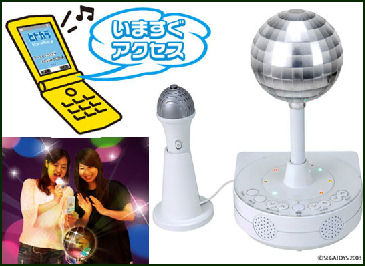
cell-phone-activated
home karaoke More and more Japanese are purchasing energy-savings appliances. New air conditioners by Toshiba, have high performance converters that use 34 percent less electricity. Hitachi makes refrigerator with freezers in the middle surrounded by vacuum insulation that use 20 percent electricity. Flat-panel televisions sold by Sony in 2008 used 40 percent less electricity than models sold three years earlier.
High Tech Toilets in Japan
The Kyushu-based Toto company, one the world largest producers of toilets, makes high-tech commodes with micro-processors that control an assortment of jets, sprays and devises. The high-tech toilets, known as Washlets have a retractable, self-cleaning wand that shoots a jet of warm water at your bottom. You control the temperatures, pressure and direction of the water with a keypad. Most also have also have driers that dry your bottom with a blast of warm air. The most advanced models cost around $4,000.

Washlets are made by robots and come equipped with bidets and blow dryers that are supposed to eliminate the need for toilet paper. Japanese bidets are notorious for squirting unsuspecting foreigners in the face, drenching their clothes and causing them to spray water all over bathroom because they can't figure out how to turn them off. Bidets have become so popular that Toto has introduced a portable one that fits into a handbag and sells for around $100.
Addressing the problem that women sometimes waste large quantities of water by repeatedly flushing the toilet to "cover up unladylike noises," Toto has equipped new state-of-the-art toilets with an electronic device, called a Sound Princess, which produces flushing sounds that hides the unladylike noises without wasting water. A portable noise-generator, which women can carry in their purse, is also available for use in public rest rooms. Japanese also spend $100 million annually on over-the-counter pills designed to prevent odors while using a toilet.
Many Westerners are baffled by the complicated array of buttons on a Japanese toilet. Describing an experience that he said was the one of the most embarrassing in his life, an American diplomat told the Washington Post he tried to flush the toilet at the dinner party of a Japanese host, but hit the flushing-noise-maker, the blow-dryer and then the bidet button and "watched helplessly as a little plastic arm, sort of squirt gun shaped like a toothbrush, appeared from the back of the bowl and began squirting a stream of warm water across the room and onto the mirror." He had to spend about ten minutes mopping up the water before rejoining the party. [Source: Mary Jordan and Kevin Sullivan, Washington Post]
According to one survey in 2005, 59 percent of homes in Japan have high-tech toilets, compared to 23 percent in 1995. Environmentalist don’t like the trend, complaining the toilets use an exorbitant amount of water and electricity. In houses that have them they use 4 percent of household electricity and 28 percent of the water.
One happy American owner of a Washlet told U.S. News and World Report, I shouldn’t say this, but sitting on that toilet is actually one of my favorite things of the day now.”
In February 2009, manufacturers of electric toilet seats equipped with warm water bidets said their products posed a potential fire risk hazard caused by defects and, in some cases, improper usage. In 2008 there were reports of several toilet fires including ones in which toilets caught fire after urine or toilet cleaning fluid came in contacted with an exposed electrical wire.
Cutting Edge Toilet Technology in Japan Models currently on the market have temperature control buttons for the bidet water, deodorizers, heated seats, fans that "break down odorous molecules," digital clocks to tell users how long they have been on the toilet, a control panel that offers a choice of flush strengths, and devices that automatically put the seat down when you are done. When Madonna visited Japan for the first time in 12 years in December 2005 she said she longed for Japan’s warm toilet seats.

The idea of the high-tech toilets, one researcher told the Washington Post is to make the bathroom a place where people can relax. In a Toto laboratory, volunteers check out new bathtubs with electrodes attached to their head that "measure brainwaves" and "the effects of bathing on the human body."
Matsushita and Toto are working on smart toilets that measure "input" and "output" and send the information to health care services. These toilets talk to their users, take their weight and blood pressure, measure body fat using electric currents, measure chemicals in the urine to determine glucose levels and, someday, cancer, and send results online to medical facilities. These toilets are being offered for $4,000 in new houses built by Daiwa house. Some new toilets have ejector-seat like contraptions that helps elderly people and handicapped people get off the seats.
Toto’s newest Neonest systems have wall control panels, stereos, buttons that adjust water pressure and air purification. There are also modals that offer massages with gentle pulses of water and anticipate the approach of users with sensing devises and open the lid automatically so you don’t have to touch anything and sends out “etiquette” music of river and bird sounds and employs deodorizers that use activated oxygen to remove odors a the molecular level and release rose and cherry blossom fragrances. Among those who have purchased them are the actor Will Smith.
There are toilets with cleansing water sprays drying-action air blasts. Eco models have sensors that measure how much water is necessary for each flush and a time memory that measures when the toilet is most heavily used and warms up the seat in advance for those time,
In December 2006, Matsushita introduced a new self-cleaning toilet, costing between $2,500 and $3,500, that is made from a new glass material and is said to never need cleaning. Toto was developed toilets with a tornado-like flush and cleaning cycle that wipes away all waste from the toilet and offers an extra wide seat for sumo wrestlers.
Clean Money Machines and Bacteria Technology in Japan
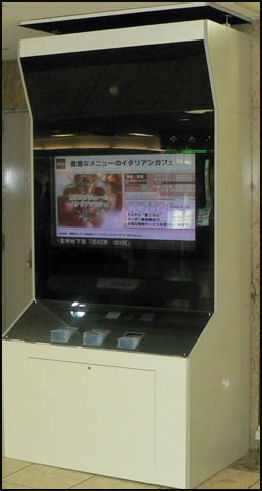
scent-emmitting machine In the late 1990s, Japanese banks introduced ATM machines that dispensed clean money. These machine take in wrinkled and dirty yen banknotes, feed them through rollers, heating them to 392̊F and dispensing the notes clean, crisp and 90 percent bacteria free. "Virgin money," Evelyn Richards wrote in the Washington Post, "plays an especially key rule at weddings, where cash is the favored gift. No respectable Japanese would give anything but untainted bills."
The clean money machines were invented by Hitachi by accident. In the process of inventing a process to iron out crumbled bills with 392̊F heat, they discovered that the high temperature also kills bacteria. Explaining why disinfected cash is popular with young women, a bank spokesmen said, many "say they don't want to touch things handled by middle-aged men."
Other appliances with health gimmicks include refrigerators that spray food with negative ions, air-purifying vacuum cleaners, ultrasound washing machines and filters that add Vitamin C to shower water. Sony uses bacteria produced cellulose to make $4,000 headphones. The waxlike cellulose is molded into speak diaphragms that have extraordinary acoustic qualities.
In August 2010, researcher at the University of Tokyo announced they had developed an odor detector that uses living cells to detect different smells. The cells have been placed in a robot that shakes its head when it detects specific odors.
Strange Inventions in Japan

hamburger-scented erasers The Japanese have a special word for strange inventions: “chindogu”, which roughly translates to "odd or distorted tool." Among the odd inventions that are described by Kenji Kawakami in his book “101 Useless Japanese Inventions: The Art of Chindogu” (Norton) are a panoramic camera made of seven individual cameras strapped around one's head; a pocket soft drink holder for people who need to use both hands for another task when they sipping a coke; and a hair protector for noodle eaters that fits around the head like a plastic sun and then folds up neatly for storage in a handbag.
Kawakami also describes a hay fever hat, with fresh tissues that hang down just above eye level; an umbrella equipped with a golf head at the tip that allows duffers to practice their swing while waiting for the subway; backscratcher T-shirts with useful "itch-locator grids”; the “dust and sake,” a combination duster and martini shakers that provides an appealing reward for doing household chores; and the sweetheart train arm, a third appendage that attaches to a jacket and helps people in "the early stages of courting” to avoid "the worry of sweaty palms, inappropriate pressure or when to disengage."
The Kowakien Inn in Hakone (two hours southwest of Tokyo) uses heavily insulated trucks to deliver hot spring water to your home in specially designed 20-liter boxes.
Dream Machine and Better Mouse Traps in Japan
The Japanese toymaker Takara has developed a machine called the Yumeinikobo — or “Dream Workshop” — which its claim can help one navigate through their dreams. Leo Lewis wrote in Time: “the gadget has various setting to manipulate dreams. Once the picture has been chosen, you write a short description of the ideal dream (flying into Dali’s painting) in a notebook, along with a note of the location (an alien planet), how you want to feel (strange), who you want to meet (my dad), what he will be wearing (a suit and tie) and what will he teach me to do (fish).”
The Dream Workshop looks like futuristic boom box The technology behind the machine is still secret. After making the notebook entrees users choose between a “love story,” “fantasy,” or “comedy” and other selections then record three key words such as “space”, “father” and “lake.” Lewis wrote “The machine plays music at gradually lower volume and slower pace for about half an hour before you nod off...in my dream my Dad dutifully appeared, not in a suit but in the appealing ensemble that he usually wears to weed the garden. Some repairs needed doing on the parsnips, he said, so we got to work. The rocket flew for only a few seconds because the stone egg ruined things.”
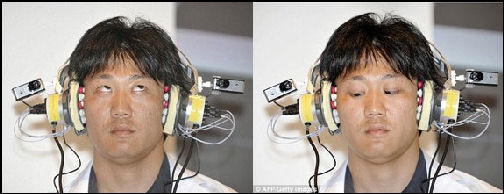
Docomo eye-control device
The Ikari Corporation has invented a computer-controlled mousetrap that automatically gets rid of pesky rodents without producing any unpleasant sights or smells. Harnessing the natural curiosity of rats and mice to explore holes, the device consists of a tube with a door that automatically closes if the temperature in the tube rises 1̊C (an indication that a rat is present). A powerful fan then kicks in that blows the rodent into freezer, where it freezes to death. Once the animal is dead the doors open, inviting others to enter. The only problem with the device is that it is rather expensive; $40,000, which some argue is justifiable because rodents are a major cause of damage to electrical wires and cables throughout Japan.
Sewage Sausage and Automated Sushi Machines
The Environmental Assessment Center in Okayama Japan announced that it had developed a revolutionary new sausage made from soybean protein, steak favoring and "sewage solids." A Reuter story in the Boston Globe quoted a company spokesman who was aware of the limitations of his product. "Sewage does have a slight image problem," he said. "I don't think people will be content eating something they know has been excreted by humans."
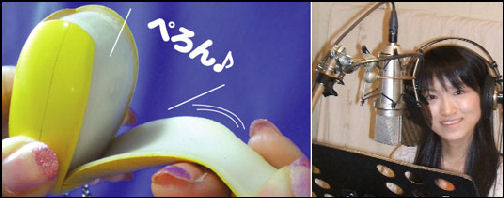
infinate banana
Takao Higashimachi, a senior researcher in the center's applied electronics division, came up with advance almost as remarkable. Using the most the latest advances in computer-aided engineering his company developed a soy sauce packet so aerodynamically efficient it can be emptied in one squirt. [Source: Tracy Dahlby, National Geographic, January 1994]
The Suzomo Machinery Company has developed an $86,000 sushi-making machine with four pairs of white plastic hands that turn out 1,200 rectangular pieces of sushi every hour for sale in fast food restaurants and supermarkets. "The hands pat the rice once, twice," writes Elaine Louie in the New York Times," Pat, pat. Wasabi, a horseradish sauce, drizzles from a tube onto the rice. Kimiche, ueki, a sushi chef, places the fish on the rice, and the plastic hands pat the rice again. the whole process takes three seconds."
A sushi chef on average can only make about 200 to 300 pieces of sushi an hour. Machine-made sushi sells for between 50 and 70 cents a piece, while human-made sushi costs $1.50 a piece or more.
Image Sources: 1) 7) Japan Visitors, 2) Nationa Museum in Tokyo 3) 4) 5) 8) 11), 12), 13), 14) xorsyst blog 6) Osaka Gas 9) 10) Toto
Text Sources: New York Times, Washington Post, Los Angeles Times, Daily Yomiuri, Times of London, Japan National Tourist Organization (JNTO), National Geographic, The New Yorker, Time, Newsweek, Reuters, AP, Lonely Planet Guides, Compton’s Encyclopedia and various books and other publications.
Last updated January 2013
